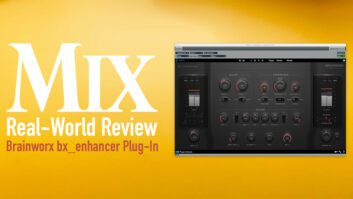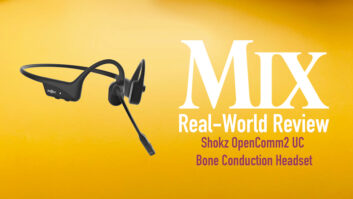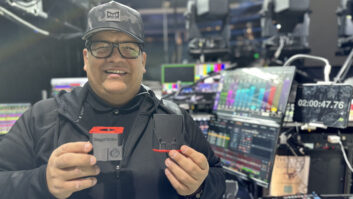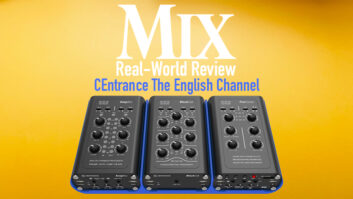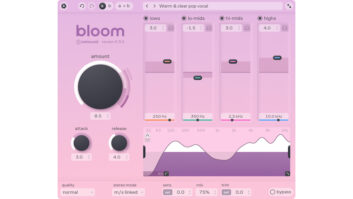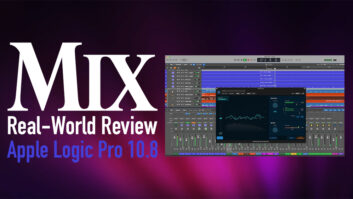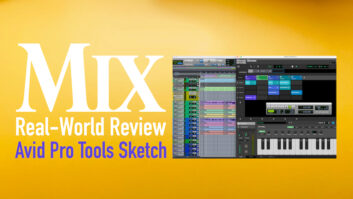Last month I began a summary of the keynote session at the November 1999 Parsons Audio Expo, an annual event in Wellesley, Mass. The session was titled “Keeping Up With Technology” and took the form of a fascinating panel discussion, which I had the privilege of moderating. Our panelists represented a wide range of folks from the New England audio community, and the discussion went on for more than two hours. I led the first part of the discussion-that’s me in italics. We continue our excerpts this month. If you missed the first part, it’s still available on our Web site, www.mixonline.com.
Besides surround sound and 24-bit/96kHz recording, what are the new technologies we’re going to have to decide about? Are we done yet with the conversion from analog to digital? Are there still dangers lurking there?
Andy Munitz (Sony): I’m different from everybody here because I’m a manufacturer, so I’m like the pusher, and these guys are the users. I’m fortunate because I get to play with a lot of great stuff, but I don’t have to pay for it. The change from analog consoles to digital consoles is something I’m smack in the middle of, and I’d like to get some input on it. There still is a sense that people want to stay with the tried-and-true analog tools they know, and they’re a little bit scared to try something new.
Look at word processing. Nobody who types as any part of their job wouldn’t say that the three hours they spent a few years ago teaching themselves how a word processor works wasn’t worth it. It changed things a lot in terms of workflow. I think digital consoles also offer a different kind of workflow. They allow you to hop back and forth between projects. A client comes in and says this didn’t work, let’s change that, and boom, there’s the snapshot. You’re back in business, and you’ve saved a lot of time. But there’s still such a strong resistance to sitting down at a new piece of major technology and giving it a shot.
Allen Smith (Soundtrack): The process of designing digital consoles has finally come of age. The first workstations were designed by people-and I’ll pick on the people at New England Digital, since we had one of the first Synclaviers that could do any editing-who started off saying, “Well, we’re going to build a box to do something, which nobody could do before, so we’re going to throw out everything we know about analog tape recorders and editing.” They assumed that everything they knew about those boxes was based on the limitations of the technology. They failed to recognize that a lot of the reason that the tape recorder has these five big buttons on the front-Stop, Play, Record, etc.-is because the human that has to use it also has this primary set of functions.
A fellow I work with used to say that if the computer guys who are designing these workstations were designing a car, then the device you use to steer the car and the device you use to turn the radio up would be of the same priority. You go to turn the radio up and you’d turn the car. (Laughter) Early on, they decided, hey, it’s a computer, we’ll make it more powerful by making it so if you hold this key down and do this, it does something else. But we don’t want that.
Jeff Largent (National Video Boston): I find workstations are more confusing, when you go from one to another, than they are similar. They’re all attempting to do the same job, but they all have very different approaches to doing it. Sometimes, because the time between [operating system] releases has become so short, a new way of doing things gets completely lost. Something may have had a truly wonderful new approach, but because it couldn’t get to the market fast enough, or not enough people adapted to it quickly enough, it’s gone. If you happen to be using that piece of equipment, you’ve watched it go from no longer available to no longer supported. That can be very frustrating.
In the workstation realm, I don’t think that enough of the programmers have basic experience doing what we do, to really understand how we go about it-and we all go about it in different ways. I design and edit sounds differently from just about anybody else I know. That’s one of the beauties of the workstations-they are so flexible that they can be anything you want-but sometimes it’s a liability, too.
Michael Bierylo (project studio owner, Berklee professor): If you can find a tool you can commit to, great. You learn the interface, and it becomes your instrument. That’s an important connection. What Jeff is saying is frustrating. Once you’ve made that connection, it’s as if you’ve been a violin player for 20 years and now they don’t make violins anymore-I’m sorry, you’ll have to learn to do that on a keyboard.
I still use an analog mixer. With all these wonderful digital mixers out there, why don’t I get one? I integrate a lot of different things: I have a Pro Tools system with plug-ins and automation, synthesizers, samplers, a tape machine, and outboard gear. I’m finding a lot of the digital mixer designs are following an older model of what a mixing console in a recording studio does, but for my needs, it takes care of part of the job but not the whole thing. Where’s the software/hardware environment that integrates everything? I want to edit my [Lexicon] PCM90 in the rack. I want a graphical user interface to appear, click a button, boom. And I want to automate that, and have the interface be seamless. Those issues have yet to be addressed. In older equipment, you have a model where everything connects together with a balanced line, and it’s one big happy family. But we have so many things we’re interconnecting in so many different ways, it’s difficult to put that together.
A gentleman in the audience just handed me a note saying, “Vendor coercion is a motivation for updating: What happens when the manufacturer stops supporting what you’ve got?” So what do you do when a Sonic Solutions announces they’re not going to support NuBus anymore? What happens when an Avid says they’re not going to support Macs anymore? What happens when an Opcode goes out of business?Jim Anderson (Sound Techniques): About five or six years ago we made a huge investment in a very major audio manufacturer who will remain nameless. After the initial investment, based on our experience with their analog side, we upped the ante. But it became apparent fairly early after the second investment that they were abandoning most of this technology that they had touted. It seemed very elegant and the interface was the most intuitive we had seen, and we were basing our long-term investment on assurance that it was going to be supported and updated in a timely manner. But this was not the case. It got worse and worse, and upgrades were only offered at a huge expense-and I mean huge!
We eventually had to walk away from that investment, which was particularly difficult to do because most of the rest of the audio world had already realized that this was dead-end technology. We were fortunate to find a couple of people for whom it was perfect-their operations were of an entirely different nature, and everyone is still happy. But, as a reaction to that, when we were deciding what to replace this technology with, we had to be very careful andwe took almost too long to make a decision.
Smith: Going back to ancient history, in ’78 or ’79 some folks and I had a small recording studio, and a fellow from 3M walked in saying, “This is what you need. You’re going to be the first digital multitrack facility in New England.” The multitrack was only $164,000, the 4-track only another $40,000, and they would do the financing. We didn’t make the jump, but somebody else did. From that moment on it became a question of when is the right moment to make the jump. If you jump early, you buy the technology at its highest price, with the most problems that you have to live through and learn how to fix-if it works for you and you survive. But then you establish the reputation of being the place that has the new, better technology.
On the other side, at one point after I started at Soundtrack, we went through a period where we were just kind of sitting back and not investing in new technology, and we watched our competitors across town take some of our work away from us because we were not keeping up.
It’s a very difficult dance. We are driven by how we perceive our commercial clients’ needs, unlike a music facility where the client walks in and says, “Do you have the Studer? What kind of noise reduction?” They have these key phrases, and they play 20 Questions, since they know that such and such was recorded this way, and it was a big hit, so they want that. Our clients are not like that. It’s our job to sell to them, so it’s a different kind of strategy. We anticipate when is the right time to present it to them, and if we do it too soon and present them with “you’ve got to do it this way,” and it fails, then we have egg on our faces.
Tom Bates (independent engineer): There’s another side of that coin. Being leading-edge can be part of what you do. I was the guy who bought the 3Ms in ’78 and ’79. What happened from that was that I ended up making virtually every record that Columbia and RCA made on the East Coast for a number of years. I happened to be that guy standing on the corner on that day, and it wasn’t really as insightful as it sounds. It was a good move. In some ways, it made my career.
What is the role of the press in all this? Are we doing more than just promoting gear lust? Should we be criticizing the manufacturers more, and be more critical in our reviews, less accepting of what people tell us? What can we do better to help people understand what’s going on in terms of adopting new technology?Scott Metcalfe (Hartt School of Music): The one thing that I have noticed is that over the years reviews seem to get kinder and kinder. The European magazines seem to be a little bit crueler. I understand it’s difficult for a magazine that makes its money off of the advertisers to say, “Well, these guys who just bought a $10,000 ad, we really don’t like what they’re selling.” It’s a tough position.
We need to know what this stuff does and if it does what they say it does and if it crashes every few minutes. Could reviewers not just say what it’s supposed to do, but tell us it really doesn’t work well in this or that application?
Part of the problem is that reviewers have even shorter product cycles than the manufacturers do. As the equipment gets more and more complicated, you find yourself having to test more and more conditions, and deal with more compatibility issues. It’s getting tough, and it’s one reason I don’t do too many reviews anymore. I remember reviewing some gear and someone wrote a terribly nasty letter saying, “Well, you never said there was this awful thing that happens under these circumstances”-and he was right, I didn’t, and when you used it that way, it completely fell down. But I had never used that piece of equipment under those circumstances, so I had no way of knowing that.
Smith: We tend to trust an inside track when we’re looking at gear. I would be more likely to call Jeff or Jim or somebody and say, “Hey, you guys have used this, did you have some problems?” Twelve years ago, Lexicon gave us the Opus to be their beta test site, and we beat the box up in a way they never anticipated. We’re in the trenches, and I don’t think it’s likely that, as a reviewer, you are going to figure out what those things are that we are going to do. And I’m not sure that the other people are going to be likely to care about it because they are not going to use it that way. So we have to figure it out for ourselves. If I’m reading a review, it allows me to stay in touch with what else is out there, but I’m not going to make a critical decision based on that because I am not expecting you to use it in the context that I will.
Bierylo: I think the educational component of the press can be real strong. With things changing so fast, magazines think of education as punditry, but there’s a difference between being an educator and being a pundit. The articles and the reviews that are most useful to me and to my students are ones that put things in a historical context, that talk about background concepts, besides just what the gear does. There are a lot of concepts, a lot of things that are appearing on boxes and pieces of software that need explaining and discussion. I think that’s a real big mission for magazines.
Reviewers have the same problem manufacturers have in marketing these things, because how do you write about what a user interface does? How do you say, “My product has a better user interface because nine out of ten post-production engineers…” (Laughter) You can talk about these things by saying this many tracks, this big, this fast, but the thing about the product that really matters to the user the most, is the thing you don’t know what to say about.
Smith: And there’s a difference between how I am going to respond, since I was doing this with analog stuff a while ago, and I bring my own mindset and limitations to it, and how a 23-year-old who just got out of school and grew up with computers is going to respond. He’s going to look at something that only has five buttons and a knob and say, “Yeah, I can do everything with this.”
(The floor was opened for questions.)
Audience member: Andy, I just want Sony to know that I am still waiting for the PCM-F1.2 to come out. (Laughter) And for the studio owners, aren’t you all starting from zero again now that our government in all its wisdom has said HDTV is real, so deal with it? I think it’s coming very fast, perhaps faster than we know.
Smith: I’ll speak for myself: It’s not starting. But I’ll defer to other people up here to tell me whether I’m right or wrong. We do commercials. What we’re going to do the first time we do a 5.1 mix is the same mix we usually do, except we’re going to take an ambience track and pull it into the back channels. It’s going to be a very safe approach, and if the people with mono TVs don’t hear it, they won’t miss it. We’re going to make sure the message is right up front and center-that’s our job. And we will very cautiously inch our way into that water.
Largent: I would support exactly what Allen is saying, more so in broadcast than any of the other disciplines. We still have to contend with the lowest common denominator. 5.1 is a great way to listen to anything, but how good is it for Good Morning America on my TV set in the kitchen? That TV set is not going to go away just because there’s Hi Def. There’s still going to be a small little monitor that people are going to want to see the news and the weather on. A 5.1 mix for that is totally overkill.
It’s the buzz that’s coming faster, but we still don’t have a delivery format. I can make a delivery format for picture; there’s still an intermediate step to produce a master format for the audio. And that isn’t editable, and the only thing that suggests that it can be is Dolby E.
Another Audience Member: Talking about the difficulties of equipment reviews, a really helpful thing could be a follow-up story six months later. Give someone a piece of complicated gear for a long time and then write a follow-up article about it in six months, when they can give a better impression about some of the features. And you could have a sidebar with testimonials from all areas of the industry talking about the equipment.
Which means the manufacturers have to cut their output in half, so we’ll have the time to do that, or we else double the size of the magazine. That’s a wonderful idea, and I would love to do it, but it would be hard to pull off for more than a handful of products. And anyway, by the time six months goes by, the product will have completely changed!
Another Audience Member: I want to go back to the first question of the discussion, and ask what people think of 24/96.
Jonathan Wyner (M-Works Mastering): I think it’s very telling that we’ve glossed over 24/96. That’s not to say that it’s not important. It falls under the category of producing something that sounds better, and therefore enhances the reputation of the facility. But it does not represent as dramatic a leap in the eyes of the consumer as surround does.
I also think that using resolution as a marketing tool has sort of come and gone. They used to put stickers that said “20-bit” on CDs. I don’t know how many CDs that actually sold, but we’ve now seen that that’s not the thing that’s going to sell another 10 million. But it does represent an incremental step in terms of fidelity of what we do, and that is an important part of the business plan, and of choosing new technologies. It’s an important part of what makes me passionate about the work I do. So at this point I work in 24 bits every single time I do anything. I don’t work in 96 kHz yet for a variety of reasons, but I will when it becomes a relatively simple task and affordable.
Bates: The benefit you get from going from 16 to 24 bits, in my opinion, is far greater than the benefit of going from 48 to 96 kHz. Going from 16 to 24 is not many more bits. But going to 96 kHz means doubling them. It’s an improvement, but not a dramatic one, and you pay for that at any moment in time because you can’t use those bits for something else. Of course, the fact is that 24/96 sounds good in 1999, and ten years from now, when we’re using the leading-edge systems, whatever they may be then, it’ll still sound good.
